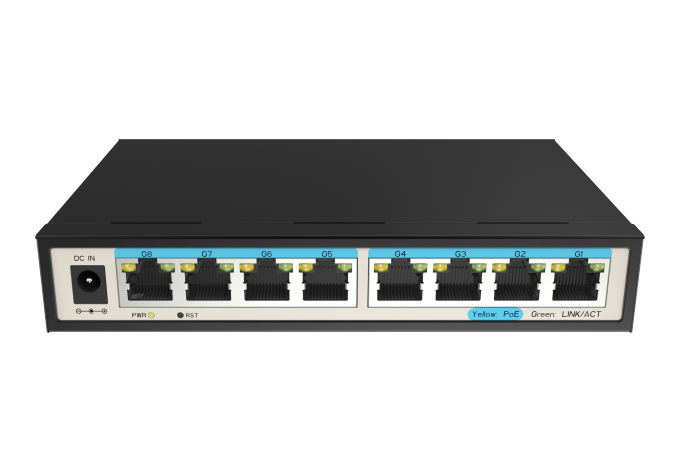POE (Power Over Ethernet) refers to the existing Ethernet Cat 5 Without any change to the cabling infrastructure, while transmitting data signals for some IP based terminals (such as IP phones, wireless LAN access points AP, webcams, etc.), the technology that can provide DC power for such devices is a switch that supports power over Ethernet.
The standard poe switch port supports an output power of 15.4W or 30W, which complies with the IEEE802.3af/802.3at standard. It supplies power to the standard POE terminal equipment through the way of network cable power supply, eliminating the need for additional power wiring; IEEE 802.3af standard is a new standard based on POE of Ethernet power supply system. It adds related standards of direct power supply through network cables on the basis of IEEE 802.3. It is an extension of existing Ethernet standards and the first international standard on power distribution. The IEEE 802.3at standard was formulated in 2005 and promulgated in 2009. The output power of 802.3at standard can reach 30W, and the available power of power receiving terminal is 25.5W.
The standard POE switch has a POE control chip inside, which has a detection function before power supply. When the device is connected, the POE switch will send a signal to the network to detect whether the IP terminal in the network has a power receiving device that supports POE. If it does, the POE switch will supply power to it. If it does not support POE, the switch will not supply power to it, which has a protective effect on the IP terminal.
The non-standard PoE switch is a power supply equipment with forced network cables. It can be powered as soon as it is plugged in. There is no detection process. Whether the terminal equipment is PoE powered by electrical equipment or not, it is very easy to damage the connecting machine equipment.

Hazards of non-standard PoE switches
At present, non-standard POE switches are widely available in the market, and their stability and reliability are not particularly good, mainly because of their insufficient power, which may cause instability of the equipment. At the same time, the unreasonable operation of the installation personnel may easily lead to the burning of the equipment. The hazards are mainly shown in the following two aspects:
Hazard 1: The voltage at the receiving end cannot be stabilized, the terminal is unstable, and the system works under undervoltage or overvoltage, which shortens the working life of the terminal.
Hazard 2: Burned equipment, electric shock, aging lines, water leakage and short circuit fire hazards! If the transmission voltage is more than 36V, the personnel are at risk of electric shock.
How to identify non-standard PoE switches? The following methods can be referred to:
1. Look at the voltage
There is no doubt that all power supply standard voltages other than 48V are non-standard products, such as common 12V and 24V power supply products. However, 48V power supply may not necessarily be a standard POE switch, which requires voltage measurement tools such as multimeter to identify whether it is a non-standard PoE switch.
Simple identification method: Start the equipment, use two multimeter probes to touch 4/5 wire and 7/8 wire of RJ45 port respectively, and the non-standard PoE switch is defined when the voltage of the dial is higher than 10V DC.
2. Measure with digital multimeter
Run the machine and equipment, adjust the multimeter to the accurate voltage measurement gear, and touch the PSE machine equipment power supply pin (generally 1/2,3/6 or 4/5,7/8 of RJ45 port number) with the two DC ammeters of the multimeter. If 48V or other voltage values (12V, 24V, etc.) are measured to output smoothly, the machine and equipment are non-standard PoE switches. On the contrary, if the incoming voltage is not measured accurately and the digital multimeter pole vibrates between 2~18V, it is a standard PoE switch. In this link, PSE is testing the PD terminal (here is a digital multimeter), and the multimeter is not a reasonable and legal PD. PSE is not easy to supply power and there is no stable voltage.
3. Select technical professional detector for testing
In order to facilitate the project installation manager to quickly identify and detect the PoE Internet route, distinguish whether the data signal has PoE power supply, whether the PoE operates normally, and whether its products are standard PoE or non-standard PoE products. The technical professional detector can be selected. The professional detector has given a set of fully intelligent test standards, which can clearly and automatically assess whether it has passed the standard test.
4. Look at the appearance of the POE Switch
In general, POE switch manufacturers attach great importance to the corporate image, and the product appearance design is also more exquisite, indicating their technical expertise. PoE switches manufactured by brand manufacturers generally have bottom label stickers, with English letters such as - P, PWR, - POE, - XP on the name of the product, or POE words on the front panel of the switch. If this is not the case, then it is likely to be fake or non-standard PoE switch.
Summary: All standard POE switches produced by regular manufacturers will not "burn out the terminal" when the equipment is running normally. Many people do not know much about POE switches, so it is unscientific to say that "POE switches are unstable and easy to burn equipment". It is recommended that you use standard POE switches to create a safe and stable network power supply environment.
Contact: sales
Phone: 18688787693
E-mail: sales@hsindustrialswitch.com
Add: Room 608, Building B,GaoXinQi TEC Park,Baoan District, ShenZhen,China